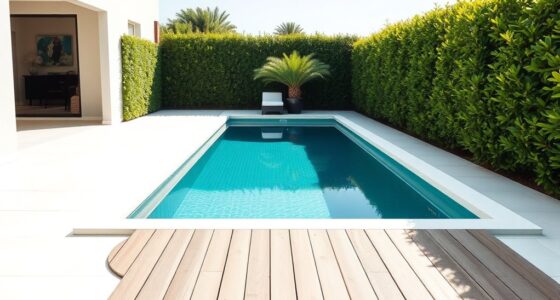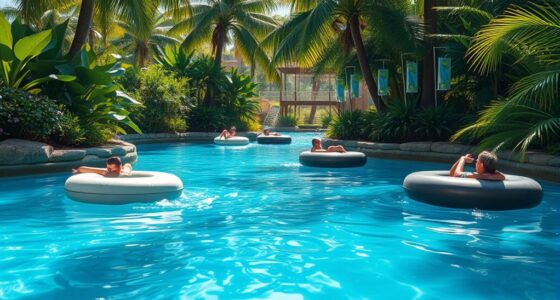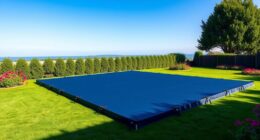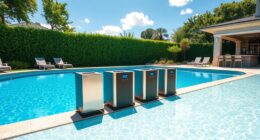Aquatic plants naturally help keep your pool water clean by absorbing nutrients, trapping debris, and releasing oxygen that supports beneficial microorganisms. They reduce the need for chemicals by acting as biological filters and controlling algae and bacteria growth. However, during heavy usage, heavy rains, or extreme temperatures, plants alone might not be enough. If issues persist, other eco-friendly methods or chemical interventions can come into play—discover more about maintaining a balanced natural swimming pool below.
Key Takeaways
- Aquatic plants naturally absorb nutrients and trap debris, reducing algae growth and improving water clarity without chemicals.
- They promote oxygenation and support beneficial microorganisms that break down waste, maintaining water balance.
- Plants are effective in moderate conditions but may be overwhelmed by heavy usage, rain, or extreme temperatures.
- Additional eco-friendly methods like UV sterilizers and mechanical filters can supplement plant filtration when needed.
- Persistent issues like persistent algae, murky water, or odors may require chemical treatments despite plant-based filtration.
The Role of Aquatic Plants in Natural Water Filtration

Aquatic plants play a crucial role in natural swimming pools by actively filtering and purifying the water. They absorb nutrients, such as nitrates and phosphates, that algae and bacteria feed on, helping prevent cloudy water and algae blooms. Roots and leaves trap debris and particles, removing impurities before they settle or cause problems. As you observe, these plants promote healthy water chemistry by releasing oxygen, which supports beneficial microorganisms that break down organic waste. Regular inspections of the plants and system ensure that they remain healthy and effective in water purification. This natural process reduces the need for chemical treatments and keeps the water clear and balanced. By choosing the right aquatic plants, you create a self-sustaining ecosystem that maintains water quality efficiently, making your swimming experience safer, more eco-friendly, and enjoyable.
How Plants Keep Water Clean Without Chemicals
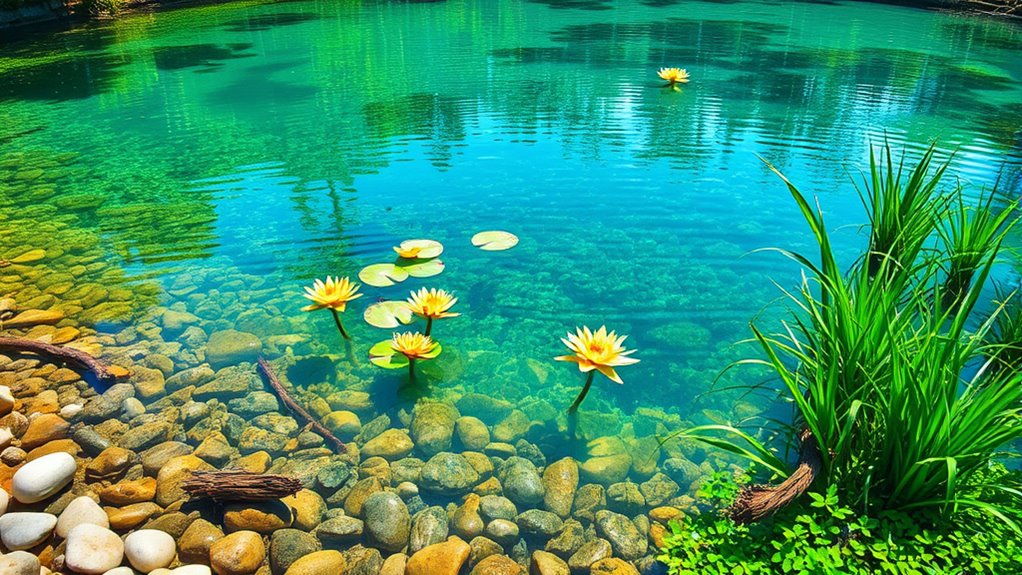
Plants naturally maintain water quality by actively absorbing contaminants and excess nutrients through their roots and leaves. They act as biological filters, preventing algae overgrowth and reducing bacteria levels. Through uptake, plants remove substances like nitrogen and phosphates, which can cause water imbalance. This natural process keeps your pool clean without chemicals. Different plants serve specific roles, such as reed beds for filtration and floating plants for nutrient absorption. Here’s a quick overview:
| Plant Type | Function | Benefits |
|---|---|---|
| Reed Beds | Mechanical & biological filter | Clearer water, stability |
| Floating Plants | Nutrient absorption | Reduce algae growth |
| Marginal Plants | Oxygenate water | Support healthy ecosystems |
| Submerged Plants | Water oxygenation | Improve water clarity |
| Emergent Plants | Habitat & filtration | Enhance biodiversity |
Additionally, selecting the right plant species can optimize water purification and support your natural swimming pool’s ecosystem.
Situations Where Plants May Not Be Enough
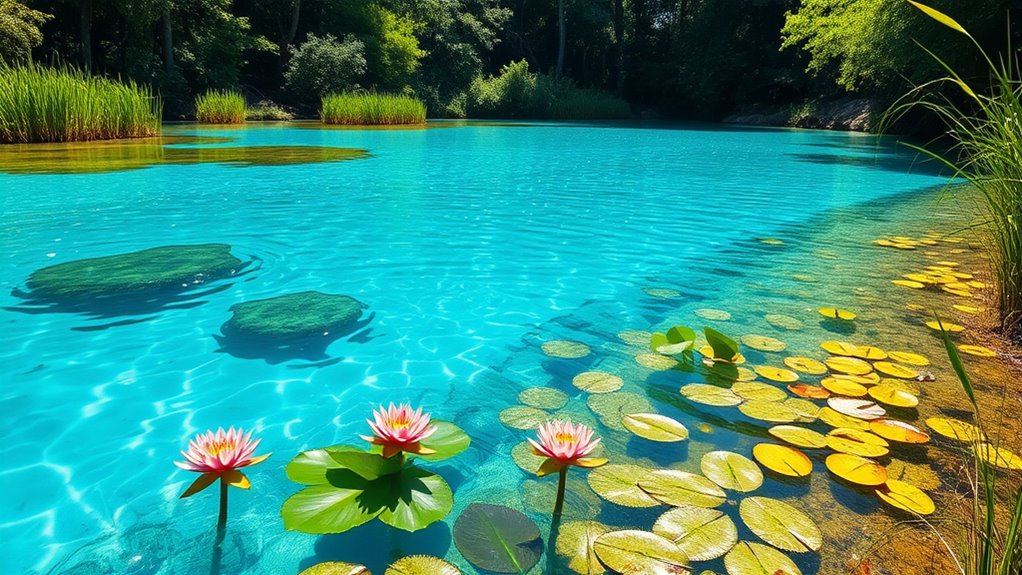
Although natural filtration by plants is effective in many situations, there are times when it simply isn’t enough to keep your pool clean. Heavy usage, like frequent swimming or large gatherings, can overwhelm the plant-based system, leading to algae blooms or cloudy water. During periods of heavy rain, runoff can introduce dirt, nutrients, and pollutants that plants alone can’t filter out quickly. Additionally, if your pool develops persistent bacteria or pathogen issues, plants may struggle to keep up without supplemental methods. Extreme temperatures can also affect plant health, reducing their filtration capacity. Furthermore, proper maintenance of filtration systems is essential to complement plant-based filtration and ensure your pool remains safe and clear.
Additional Methods to Maintain Water Quality

When natural filtration isn’t enough to keep your pool clear, adding supplementary methods becomes necessary. These techniques help maintain water quality and prevent issues.
- UV Sterilization: Installing a UV system kills bacteria and algae without chemicals, keeping water safe and clear.
- Ozone Generators: Ozone boosts oxidation, reducing organic matter and contaminants efficiently.
- Mechanical Filtration: Using a high-quality pump and filter traps debris and particles, preventing buildup and cloudiness.
Implementing these methods alongside your plant-based system ensures your pool stays inviting and healthy. They offer effective, eco-friendly alternatives or supplements to chemical treatments, especially during peak swimming seasons or when water quality fluctuates. Remember, combining natural and supplementary methods helps you achieve a pristine, balanced swimming environment.
Signs That Indicate a Need for Chemical Intervention
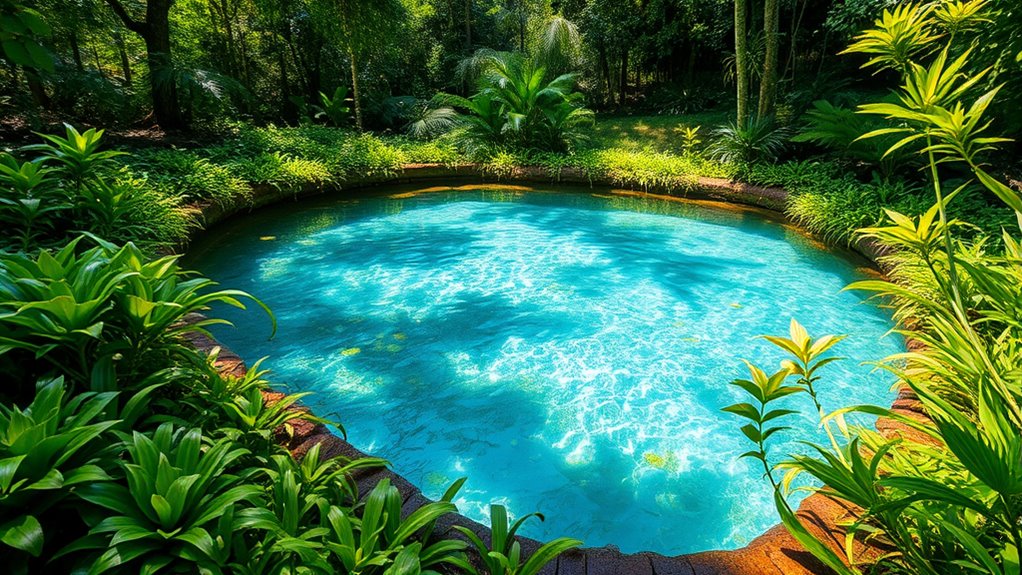
Even with natural filtration in place, your pool may occasionally show signs that chemical intervention is necessary. If you notice persistent algae growth despite your efforts, it’s a clear sign your system needs a boost. Cloudy or murky water also indicates imbalance, making it hard for plants to keep up. Unpleasant odors or a slimy surface point to bacteria buildup that natural methods can’t fully control. Additionally, if your pH levels are constantly fluctuating or you see white deposits on surfaces, chemical tweaks may be needed. Don’t ignore these signs; they signal your ecosystem is overwhelmed or out of balance. Addressing these issues promptly with targeted chemicals can restore water clarity and health, ensuring your pool remains a safe and enjoyable environment.
Frequently Asked Questions
How Long Does It Take for Plants to Establish a Natural Swimming Pool?
It typically takes about 3 to 6 months for plants to fully establish in your natural swimming pool. During this period, you’ll notice water clarity improve as plants develop their root systems and balance the ecosystem. To speed up the process, guarantee you select the right plants, provide adequate sunlight, and avoid heavy use of chemicals. Patience and proper maintenance will help your pool reach its natural balance efficiently.
Can Natural Pools Be Used Year-Round in Colder Climates?
Yes, you can use natural pools year-round in colder climates, but you’ll need to take extra steps. Insulate the pool and install a heater to maintain water temperatures, and use a floating cover to reduce heat loss. Keep in mind, biological filtration slows down in winter, so occasional maintenance or added sanitization might be necessary. With proper care, your natural pool can remain inviting regardless of the season.
What Types of Plants Are Most Effective for Filtration?
You should choose aquatic plants like water lilies, cattails, and submerged plants such as hornwort and eelgrass for effective filtration. These plants help absorb nutrients, filter debris, and promote healthy water clarity. Water lilies shade the pond, reducing algae growth, while cattails and submerged plants improve oxygen levels and trap pollutants. Make certain you select native species suited for your climate to maximize their filtration abilities and maintain a balanced ecosystem.
How Often Should I Prune or Replace Aquatic Plants?
You should prune your aquatic plants regularly, about once every few weeks, to keep them healthy and prevent overgrowth. Substitute any dead or dying plants as soon as you notice issues to maintain proper water filtration. During peak growing seasons, more frequent pruning may be necessary, roughly every 2-4 weeks. Consistent care ensures your natural pool stays balanced and clear, so stay attentive to your plants’ needs.
Are There Safety Concerns With Relying Solely on Plants for Water Cleanliness?
Relying solely on plants for water cleanliness can pose risks if you’re not vigilant. While they naturally filter out impurities, unexpected algae blooms or plant decay might threaten water safety. You must monitor water quality regularly, ensuring proper plant health and balance. If overlooked, these issues could compromise safety, making chemical treatments or additional filtration necessary. Stay alert and proactive to keep your pool both beautiful and safe.
Conclusion
Natural swimming pools rely heavily on plants to keep water clean, reducing the need for chemicals. Did you know that, on average, aquatic plants can filter up to 90% of impurities? But remember, there are times when plants alone might not suffice—like during heavy rain or algae blooms. By staying vigilant for signs like cloudiness or foul odors, you can decide when to step in with additional treatments, keeping your pool safe and eco-friendly.


